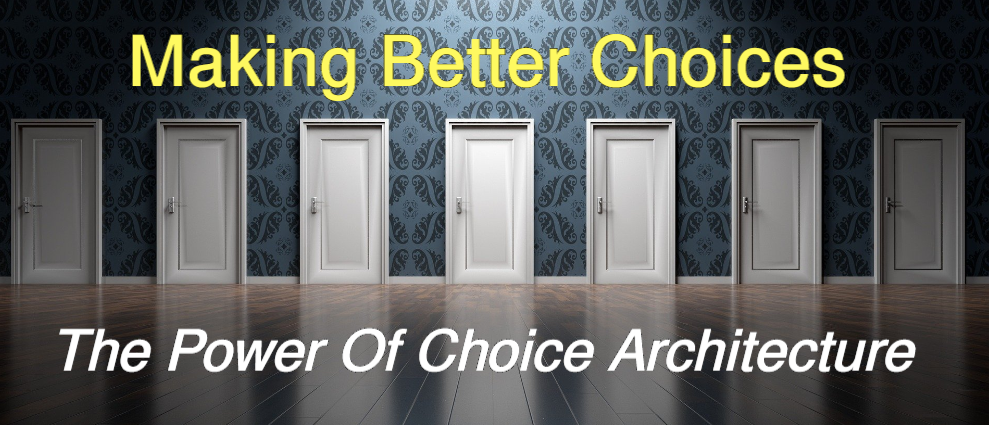
choice architecture: influencing choice by designing the context in which choices are presented
Life is about choices. Every day presents hundreds of choices. How we make those choices is less random than you may think. Which choice we make is influenced by lots of factors interacting – experience, knowledge, values, preferences, biases, timing, senses, etc.
The core principle of choice architecture is that how those factors are designed, organized and presented can substantially impact what choices people make. And that has dramatic implications in virtually every aspect of life – commerce, politics, government, public health, recreation, nutrition, etc. – virtually any choice we make can be influenced (or “nudged”) by how and when that choice is designed, organized and presented. In other words, choice architecture is a bigger deal than most of us think about as we go about our lives.
The term “choice architecture” was coined in 2008 by R.H. Thaler and C.R. Sunstein in their groundbreaking book Nudge: Improving decisions about health, wealth, and happiness.
Some real-life examples of choice architecture include:
Choice Overload – Have you ever noticed that, when presented with too many choices, you hold back making a choice, almost paralyzed? You can see it in all the Medicare enrollment commercials – so many choices! Which one is best for me? Where do I start to find the best option? The result is often hesitancy to commit and a tendency to postpone the choice until the last minute in the enrollment period when sound judgment is least effective (or not make a choice at all).
Limiting choices can seem counterintuitive. People like choice. But finding the optimum number of choices in any situation that will motivate action is critical whenever you ask someone to choose. People tend to prefer simplicity over complexity. Simplifying and narrowing choice follows our brain’s innate “work rules.”
Defaults – designing a choice so that one selection is pre-selected and individuals must take active steps to select another option. For example, designing a form in which the “default” selection box you would prefer the person to check is already checked, and the person must uncheck the box to make another selection. All things being equal, the tendency to choose default selections is universal.
Ordering Choices – The order in which choices are presented matters. We see this in elections where the placement of candidate choices on a ballot impacts results. Being at or near the top of the ballot can affect voting by a few percentage points – sometimes enough to determine outcomes.
Another example is seen in the buffet line. Food items at the beginning of the buffet tend to more likely appear on your tray than items at the end of the line. So, obviously, in school cafeterias presenting healthy-eating choices at the beginning of the buffet line is good nutritional policy.
Choice Placement – Those same cafeterias can significantly increase selection of healthy-eating choices by placing those choices at eye level.
There are many other examples that could be cited. Choice architecture today is everywhere. It’s a very big deal. It’s part of virtually every business plan, economic model, political strategy, public health initiative, etc. Proponents consider it influencing better choices for good. Critics consider it manipulating choice and suppressing individual freedom.
The purpose of this post is not to influence how you think of choice architecture in today’s complex, information-overloaded, heavily biased environment. This post is more of a reminder that each of us is constantly being influenced (or manipulated) by people, businesses, politicians, governments, etc. to make preferred choices.
So many choices today come in a strategically biased form intended to influence our choice.
The growing challenge is to proactively recognize these influences and train ourselves to step back for a moment before making choices to evaluate HOW and HOW MUCH we are being influenced.
Making informed, rational and intelligent choices today is challenging. And they will get continually more challenging as choice architecture grows more and more sophisticated and science-based every day.
The science of choice architecture is only about 15 years old. Business strategists, marketers, social scientists, politicians are learning, testing and refining strategies to more effectively influence us every day – good guys and bad guys.
So the burden falls squarely on us to be more vigilant and self-aware...
to build into our decision-making a selective pause before making choices... to reflect on how that choice has been designed, organized and presented to influence our choice... so that we can make better choices that best reflect what we really need and want.
To be better consumers, better citizens, better parents... to make better choices more consistently... we must be in charge of our choices. So this post is about choice “awareness.” The more aware we are of the influences that color our choices, the better our choices will be.
Join our EverAgeless community.
Check out my new book EverAgeless: 6 Steps To An Ageless Life now available on Amazon (and please leave a review if you like it).
Check out our archive of past blog posts. There are lots of interesting topics there.